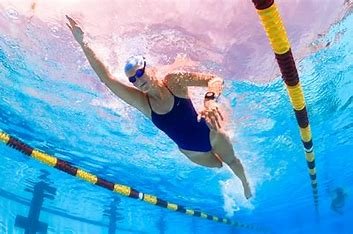Swimming is an excellent choice for full-body conditioning due to its low-impact nature and the wide range of muscles it engages.

Impact on Muscles
- Upper Body:
- Shoulders: Swimming strokes like the freestyle (front crawl) and butterfly activate the deltoid muscles, strengthening the shoulders.
- Back: Strokes like backstroke and breaststroke target the upper and lower back, helping to improve posture and overall back strength.
- Arms: Swimming requires continuous arm movement, engaging the biceps, triceps, and forearms, leading to toned and stronger arms.
- Core:
- Swimming requires a strong, stable core to maintain proper form and balance in the water. It engages the abs, obliques, and lower back muscles.
- Movements like the flutter kick and the use of the core for stabilization during strokes enhance core strength, improving posture and body control.
- Lower Body:
- Legs: The kicking movements in swimming, such as those in freestyle and breaststroke, work the quadriceps, hamstrings, calves, and glutes. These muscles become more toned and endurance-focused over time.
- Glutes: In particular, the butterfly stroke and freestyle can activate the glutes significantly, which helps build strength in the lower body.
Cardiovascular Conditioning
- Heart Health: Swimming is an excellent cardiovascular workout. It increases your heart rate while being gentle on the joints, providing an effective way to improve overall heart health.
- Endurance: Swimming builds stamina and improves your VO2 max (the body’s ability to use oxygen efficiently), which is key to cardiovascular conditioning.
- Breathing: Swimming involves controlled breathing techniques, helping to enhance lung capacity and teach efficient oxygen use under exertion.
Joint-Friendly
- Low-Impact: One of the biggest advantages of swimming is that it is easy on the joints. The buoyancy of water supports your body weight, reducing the strain on joints and bones. This makes it ideal for people with joint pain, arthritis, or those recovering from injuries.
Full-Body Coordination
- Body Awareness: Swimming requires coordination of multiple muscle groups at once, improving overall body awareness and motor skills. Each stroke requires a blend of movements from the arms, legs, and core, helping to enhance proprioception (awareness of body position in space).
Flexibility and Range of Motion
- The range of motion needed for different strokes—like the shoulder rotation in freestyle or the leg kicks in breaststroke—helps to increase flexibility, particularly in the hips, shoulders, and ankles.
Mental Health Benefits
- Stress Relief: The rhythmic nature of swimming, combined with the soothing effect of water, helps reduce stress and anxiety. Swimming also triggers the release of endorphins, improving mood.
- Mind-Body Connection: The focus required to maintain proper technique and breathing fosters a deeper mind-body connection, contributing to mental clarity and relaxation.
Weight Loss and Fat Burning
- Swimming can be an effective workout for weight loss. The combination of resistance from water and aerobic activity burns a significant amount of calories, especially when you swim at higher intensities or for longer durations.
Overall Conditioning:
- Balance: Swimming helps improve balance and coordination through the continuous movement of limbs and stabilization in the water.
- Flexibility: Stretching while swimming helps with overall flexibility, especially in the shoulders, hips, and legs.
Popular Swimming Strokes and Their Benefits:
- Freestyle (Front Crawl):
- Full-body workout with emphasis on the shoulders, chest, and core.
- Breaststroke:
- Focuses on the chest, arms, and legs while being more gentle on the joints.
- Backstroke:
- Engages the back, shoulders, and arms, while being a great way to improve posture.
- Butterfly:
- Intense full-body workout that primarily targets the chest, shoulders, and core.
Summary of Benefits:
- Tones and strengthens muscles across the entire body.
- Improves cardiovascular health and endurance.
- Low-impact and joint-friendly.
- Enhances flexibility and range of motion.
- Promotes mental well-being through stress relief and focus.
- Great for all fitness levels, from beginners to athletes.
